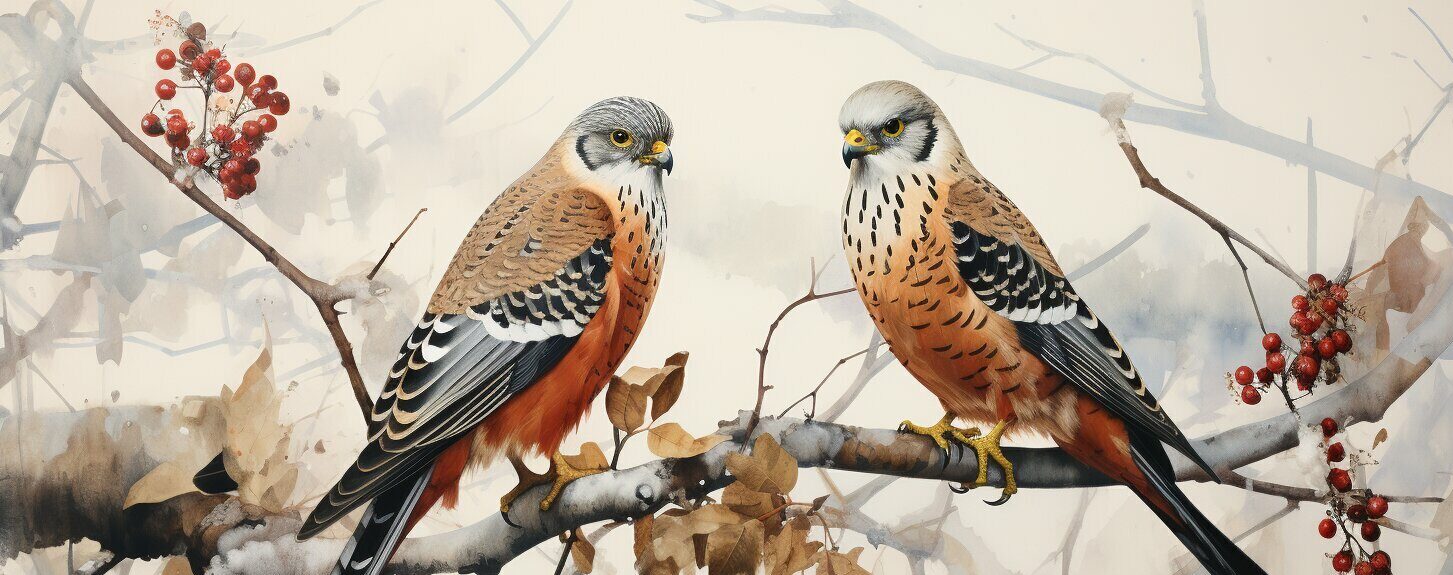Toucans and kingfishers are two types of birds that have distinct characteristics and behaviors. While both birds belong to the Aves class and have feathers, their differences far outweigh their similarities. Toucans are known for their colorful feathers and large, hollow beaks, while kingfishers have sleek bodies and sharp, pointed beaks. Their habitats, diets, and nesting habits also differ significantly. Let’s explore these differences in more detail.
Key Takeaways:
- Toucans have colorful feathers and large, hollow beaks, while kingfishers have sleek bodies and sharp, pointed beaks.
- Toucans are primarily found in tropical rainforests, while kingfishers inhabit a variety of habitats.
- Toucans are herbivorous, while kingfishers have a carnivorous diet.
- Toucans build nests in crevices, while kingfishers burrow their nests in the ground.
- Toucans have a longer lifespan compared to kingfishers.
Physical Appearance
When it comes to the physical appearance of toucans and kingfishers, there are several notable differences. Let’s explore these differences in more detail.
Feathers and Crests
Toucans have shiny black feathers with splashes of white, yellow, red, green, and blue, giving them a vibrant and colorful appearance. They also have prominent crests on their heads, adding to their distinctive look. On the other hand, kingfishers have feathers that come in shades of blue, green, turquoise, and gold, which provide them with excellent camouflage in their natural habitats. Unlike toucans, kingfishers do not have crests on their heads.
Eyes and Other Senses
When it comes to their eyes and other senses, toucans have ivory-colored eyes, which add to their striking appearance. Their eyesight is adapted to living in the dense forests where they reside. Kingfishers, on the other hand, have dark brown eyes that allow them to spot and catch their prey with precision. Additionally, both toucans and kingfishers have sharp senses of hearing.
Wings and Tail
Both toucans and kingfishers have broad wings and long tails, which are essential for their ability to fly and maneuver through their respective environments. Toucans have fan-shaped tails, while kingfishers have yellow tails that are often used for courtship displays.
Beak and Claws
One of the most noticeable differences between toucans and kingfishers is their beaks. Toucans have large, chisel-shaped beaks that are lightweight despite their size. These beaks are adapted for reaching and picking fruit from trees and are also used for defense. On the other hand, kingfishers have sharp, pointed beaks that are well-suited for catching fish, their primary source of food. In terms of claws, toucans have black claws with white spots or blotches, while kingfishers have large claws that aid in perching and capturing prey.
Habitat and Behavior
Toucans and kingfishers have distinct habitats and behaviors that contribute to their unique characteristics. When it comes to habitat, toucans are primarily found in tropical rainforests, where the dense vegetation provides them with ample food sources and shelter. They are well-adapted to the humid and hot climate of these regions, and their vibrant colors help them blend in with the lush foliage. On the other hand, kingfishers inhabit a diverse range of habitats, including rivers, forests, grasslands, and even deserts. Their ability to adapt to different environments allows them to thrive in various ecosystems.
The behavior of toucans and kingfishers also differs significantly. Toucans are known for their lively and social nature. They often travel in small groups and communicate with each other using a variety of calls, including soft croaks and loud screams. Toucans are diurnal birds, meaning they are most active during the day. They spend their time foraging for fruits, insects, frogs, and small reptiles. Kingfishers, on the other hand, are solitary birds that are excellent hunters. They have keen eyesight and can spot their prey from above the water’s surface. With a swift dive, they catch fish, crabs, crayfish, snails, frogs, insects, spiders, reptiles, and even small mammals.
Quote: “Toucans are known for their lively and social nature. They often travel in small groups and communicate with each other using a variety of calls, including soft croaks and loud screams.”
The migration patterns of toucans and kingfishers vary. While there is limited information available about their migratory behavior, some species of kingfishers are known to migrate over long distances, following the availability of their prey and favorable weather conditions. Toucans, however, are generally considered non-migratory birds, as they prefer to remain in their tropical rainforest habitats year-round. Their ability to find food and resources in their primary habitat eliminates the need for long-distance migrations.
| Toucans | Kingfishers | |
|---|---|---|
| Habitat | Tropical rainforests | Rivers, forests, grasslands, deserts |
| Behavior | Lively and social, diurnal | Solitary, excellent hunters, diurnal |
| Prey and Diet | Fruits, insects, frogs, small reptiles | Fish, crabs, crayfish, snails, frogs, insects, spiders, reptiles, small mammals |
| Activity | Active during the day | Active during the day |
| Migration | Non-migratory | Some species migrate |
Nesting and Breeding
Toucans and kingfishers exhibit distinct nesting and breeding behaviors. Let’s explore the differences in their nest type and building, breeding behavior, sexual maturity, incubation and hatching, and the characteristics of their young ones.
Nest Type and Building
Toucans build their nests in the crevices of rocks or tree hollows using a combination of natural materials such as feathers, sticks, plants, soil, roots, and other available resources. Their nests are often large and composed of multiple chambers to accommodate their eggs and young ones. Kingfishers, on the other hand, construct their nests by burrowing holes in the ground, usually near bodies of water or riverbanks. These burrows provide protection from predators and serve as safe spaces for their eggs and chicks.
Breeding Behavior and Sexual Maturity
During the breeding season, both toucans and kingfishers engage in courtship displays to attract mates. Toucans are monogamous birds, forming long-lasting pair bonds. They engage in mutual preening and vocalizations as part of their courtship rituals. Kingfishers, on the other hand, are also known for their elaborate courtship displays, which involve aerial acrobatics and intricate calls. They can be either monogamous or polygamous depending on the species.
Toucans typically reach sexual maturity at around 3-4 years of age, while kingfishers become sexually mature at about 1 year of age. Once they reach maturity, they actively participate in the breeding process to ensure the survival of their species.
Incubation and Hatching
Female toucans take the responsibility of incubating their eggs, using their bodies to provide warmth and protection to the developing embryos. The incubation period for toucans can last between 16 to 20 days, depending on the species. In contrast, both male and female kingfishers take turns incubating their eggs. The incubation period for kingfishers can range from 17 to 24 days, depending on the species.
Once the eggs hatch, toucan chicks are blind and naked, relying on their parents for warmth, protection, and food. Kingfisher chicks, on the other hand, are born with a thin layer of down feathers and are able to open their eyes shortly after hatching. They are also dependent on their parents for food and care.
Young Ones
Toucan chicks grow rapidly and are fed regurgitated food by their parents until they are ready to fledge. Their diet includes insects, frogs, small reptiles, fruits, and other suitable prey. Kingfisher chicks also grow quickly, and their diet primarily consists of fish, aquatic invertebrates, and other small prey that their parents catch for them. Both toucans and kingfishers invest significant energy in raising and nurturing their young ones, ensuring their survival and successful integration into their respective environments.
| Nesting and Breeding Characteristics | Toucans | Kingfishers |
|---|---|---|
| Nest Type and Building | Tree hollows, crevices, or constructed nests using feathers, sticks, plants, soil, roots, and other materials. | Burrows in the ground near bodies of water or riverbanks. |
| Breeding Behavior | Monogamous. Courtship displays involve mutual preening and vocalizations. | Monogamous or polygamous. Elaborate courtship displays with aerial acrobatics and calls. |
| Sexual Maturity | 3-4 years of age. | Around 1 year of age. |
| Incubation and Hatching | Female incubates eggs for 16 to 20 days. | Both male and female take turns incubating eggs for 17 to 24 days. |
| Young Ones | Blind and naked at birth. Depend on parents for warmth, protection, and regurgitated food. | Born with down feathers, able to open eyes shortly after hatching. Depend on parents for food and care. |
Lifespan and Classification
Toucans and kingfishers have varying lifespans depending on their species. On average, toucans live for around 18 years, while kingfishers have a lifespan of approximately 14 years. These numbers may differ based on factors such as habitat, diet, and predation.
Toucans belong to the family Ramphastidae and the genus Pteroglossus. Within the toucan family, there are different species, including Selenidera and Megaceryle maxima. Each species has its own unique characteristics and traits. The scientific names of specific toucan species are determined through taxonomic classification to ensure accurate identification and study.
Kingfishers, on the other hand, belong to the family Alcedinidae and the genus Ceyx. Similarly to toucans, kingfishers are further classified into species such as Ispidina lecontei and Dacelo novaeguineae. These classifications help scientists and researchers categorize and study the different variations and behaviors of kingfisher species.
| Toucans | Kingfishers |
|---|---|
| Lifespan: Approximately 18 years | Lifespan: Approximately 14 years |
| Family: Ramphastidae | Family: Alcedinidae |
| Genus: Pteroglossus | Genus: Ceyx |
| Species Examples: Selenidera, Megaceryle maxima | Species Examples: Ispidina lecontei, Dacelo novaeguineae |
Understanding the lifespan and scientific classification of toucans and kingfishers helps to further our knowledge and appreciation for these fascinating bird species. By studying their lifespans and classifying them into different groups, we can gain insights into their unique characteristics, behaviors, and ecological roles.

Conclusion
In conclusion, the differences between toucans and kingfishers are evident in their physical appearance, habitat, behavior, nesting and breeding habits, lifespan, and classification. Toucans are known for their vibrant and colorful feathers, large and hollow beaks, and herbivorous diet, while kingfishers possess sleek bodies, sharp and pointed beaks, and a carnivorous diet.
These birds occupy distinct habitats, with toucans primarily found in tropical rainforests and kingfishers inhabiting various environments such as rivers, forests, grasslands, and deserts. Additionally, toucans are diurnal birds, active during the day, while kingfishers also display diurnal behavior.
In terms of nesting and breeding, toucans construct their nests in rock crevices using feathers, sticks, and other materials, whereas kingfishers dig burrows in the ground. Toucans reach sexual maturity at around 3-4 years, while kingfishers mature at approximately 1 year. The incubation process also differs, with toucans having the female solely responsible, while both kingfisher parents actively participate.
While toucans typically have a lifespan of about 18 years and are classified in the family Ramphastidae, kingfishers have a lifespan of around 14 years and belong to the family Alcedinidae. Understanding these differences not only enhances our knowledge of these avian species but also fosters a deeper appreciation for the incredible diversity found in the world of birds.
FAQ
What are the differences between Toucans and Kingfishers?
Toucans and Kingfishers differ in their physical appearance, habitat, behavior, nesting and breeding habits, lifespan, and classification.
What are the physical characteristics of Toucans and Kingfishers?
Toucans have colorful feathers, large beaks, and prominent crests. Kingfishers have sleek bodies, sharp beaks, and feathers in shades of blue, green, turquoise, and gold.
Where do Toucans and Kingfishers live?
Toucans primarily inhabit tropical rainforests, while Kingfishers can be found in various habitats including rivers, forests, grasslands, and deserts.
What do Toucans and Kingfishers eat?
Toucans have a herbivorous diet and mainly feed on fruits, insects, frogs, and small reptiles. Kingfishers have a carnivorous diet and feed on fish, crabs, crayfish, snails, frogs, insects, spiders, reptiles, and small mammals.
How do Toucans and Kingfishers build their nests?
Toucans build their nests in the crevices of rocks using feathers, sticks, plants, soil, and other materials. Kingfishers burrow their nests in the ground.
What is the lifespan of Toucans and Kingfishers?
Toucans have a lifespan of around 18 years, while Kingfishers have a lifespan of around 14 years.
How are Toucans and Kingfishers classified?
Toucans belong to the family Ramphastidae and the genus Pteroglossus, while Kingfishers belong to the family Alcedinidae and the genus Ceyx.
 Skip to main content
Skip to main content


